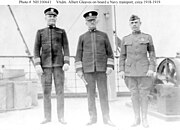m (Remove some templates. interwiki links and cleanup, replaced: {{flag|United States of America}} → United States) |
m (Remove some templates. interwiki links and cleanup, removed: 25px) |
||
| Line 11: | Line 11: | ||
|placeofburial_label= Place of burial |
|placeofburial_label= Place of burial |
||
|allegiance= [[United States of America|United States]] |
|allegiance= [[United States of America|United States]] |
||
| − | |branch= |
+ | |branch= [[United States Navy]] |
|serviceyears=1877-1921 |
|serviceyears=1877-1921 |
||
|rank= [[File:US-O10 insignia.svg|35px]] [[Admiral (United States)|Admiral]] |
|rank= [[File:US-O10 insignia.svg|35px]] [[Admiral (United States)|Admiral]] |
||
| Line 43: | Line 43: | ||
</gallery> |
</gallery> |
||
| − | ==See also== |
||
==References== |
==References== |
||
:{{DANFS}} |
:{{DANFS}} |
||
Revision as of 02:25, 5 November 2013
| Albert Gleaves | |
|---|---|
 Admiral Albert Gleaves (center) | |
| Born | January 1, 1858 |
| Died | January 6, 1937 (aged 79) |
| Place of birth | Nashville, Tennessee |
| Place of death | Haverford, Pennsylvania |
| Place of burial | Arlington National Cemetery |
| Allegiance | United States |
| Service/branch | United States Navy |
| Years of service | 1877-1921 |
| Rank |
|
| Commands held |
Asiatic Fleet USS Cushing |
| Battles/wars |
Spanish-American War World War I |
| Awards |
Distinguished Service Medal Army Distinguished Service Medal |
| Other work | author |
Albert Gleaves (January 1, 1858 – January 6, 1937) was an admiral in the United States Navy, also notable as a naval historian.
Biography
Born in Nashville, Tennessee, Gleaves graduated from the United States Naval Academy in 1877. After serving on board USS Hartford and Trenton, he was appointed an Ensign in 1881. Assigned to many ships and stations, he commanded Cushing during the Spanish-American War and later the battleship North Dakota. Promoted to Rear Admiral in 1915, in World War I he commanded the Cruiser and Transport Force. For his outstanding contribution he was awarded the Army and Navy Distinguished Service Medals.
In 1919 he was promoted to Admiral and commanded the Asiatic Fleet. While serving at the Naval Ordnance Proving Ground, Admiral Gleaves made outstanding contributions in the field of gunnery and torpedoes. While carrying out some tests on torpedo steering devices he changed these weapons from instruments of luck into instruments of precision. The gear which he tested in Gushing provided the imprints which made the torpedo the "terrible weapon" of World War I.
In spite of a life of constant action in war and peace, he found time to write a biography of Captain James Lawrence; the History of the Cruiser and Transport Force, and the Life of an American Sailor, William Hensley Emory, Rear Admiral, USN. After a most distinguished career, he retired in 1921.
Admiral Gleaves died at Haverford, Pennsylvania, a few days after his 79th birthday.
He has been quoted as saying, "To seamen a ship becomes endowed with human virtues and faults; she ceases to be a mere inanimate thing."
Namesake
The destroyer USS Gleaves (DD-423) was named after him.
Gallery
References
- This article incorporates text from the public domain Dictionary of American Naval Fighting Ships.
External links
His memoirs, titled "The Admiral: the Memoirs of Albert Gleaves, Admiral, USN," was published in 1985 by Hope Publishing House, Pasadena, California (HOPE ISBN 0-932727-02-6).
